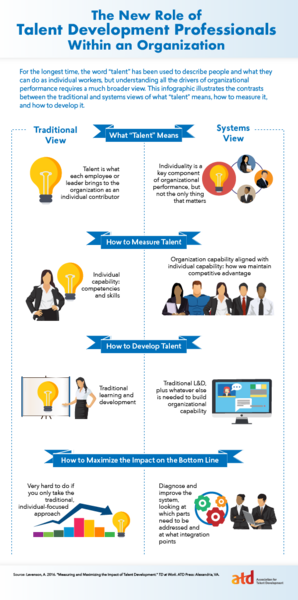ATD Blog
Responding to Change: The Evolving Role of the Talent Development Professional
Thu Aug 02 2018


Humans have been teaching each other to do things since the dawn of time. But it was the industrial revolution that solidified the need for training and the role of corporate trainer.
In a previous post, I wrote about the evolution of the talent development field. It is no surprise that as the field has evolved, so has the role of the talent development professional. Most of that evolution however has been within the last 80 years.
It was the World War II industrial effort that drove the first major evolution away from vocational school training. As Kevin Oakes noted in his chapter, “The Evolution of the Training Profession” in the ASTD Handbook: The Definitive Reference for Training & Development, 2nd Edition, “To supply much-needed trainers, the Training Within Industry Service of the War Manpower Commission developed the Job Instructor Program, or JIT. The JIT’s purpose was to teach first- and second-line supervisors how to teach their skills to others. These train-the-trainer programs came to be known as J programs and expanded to include topics such as human relations, job methods, safety, and program development.”
Instructional design also evolved during this time as the military applied a systems approach to learning design.
1950s – 1970s
In the late 1950s and early 1960s, measurement of training and the need to understand business emerged as key themes that drove evolution in the field. Oakes notes that Gordon M. Bliss, then executive director for ASTD (now ATD), “urged members to seek ‘wider responsibilities’ and to understand ‘the vernacular which is used to report profits'.”
Advances in the behavioral sciences impacted the evolution of the talent development profession too. The work of B.F. Skinner (behaviorism), Benjamin Bloom (learning objectives), Jean Piaget (cognitive development), Malcolm Knowles (adult learning), and others advanced the understanding that “training” was more than just an event to teach new skills. Deeper understanding of learning drivers and learning theories meant increased opportunities to design and deliver more relevant programs.
1980s – 2000s
Technology is perhaps the single largest factor contributing to the evolution of the talent development professional’s role.
The 1980s welcomed the presence of computer workstations and since that time, the pace of technological change has influenced workplace learning and talent development professionals. “Training” no longer needed to be delivered in a classroom or in person. E-learning emerged in the 1990s, and the introduction of the iPhone and tablets in the mid-2000s welcomed mobile learning, virtual classrooms, and big data.
Beyond classroom training, talent development professionals had to become technologically literate and business-savvy. The role of the TD professional has expanded to one of collaborators and curators of learning. Specializations within the field have emerged, which are reflected in ATD’s Competency Model.
It was this broadening of the roles and responsibilities of TD professionals that led to the 2014 rebrand of the American Society for Training & Development (ASTD) to the Association for Talent Development.
Future of Work
Today, we look forward to what the future of work will require of the talent development field. Technology, no doubt, will continue to drive change. Augmented reality, virtual reality, and artificial intelligence are already part of the workplace in many organizations. TD professionals must be agile and ready to anticipate how these technologies can and will affect their organizations.
In their excellent book, Human and Machine: Reimagining Work in the Age of AI, Paul R. Daugherty and H. James Wilson provide valuable insights into how talent development professionals need to prepare for a workplace where humans work alongside robots. New opportunities for talent development are on the horizon.
You've Reached ATD Member-only Content
Become an ATD member to continue
Already a member?Sign In
